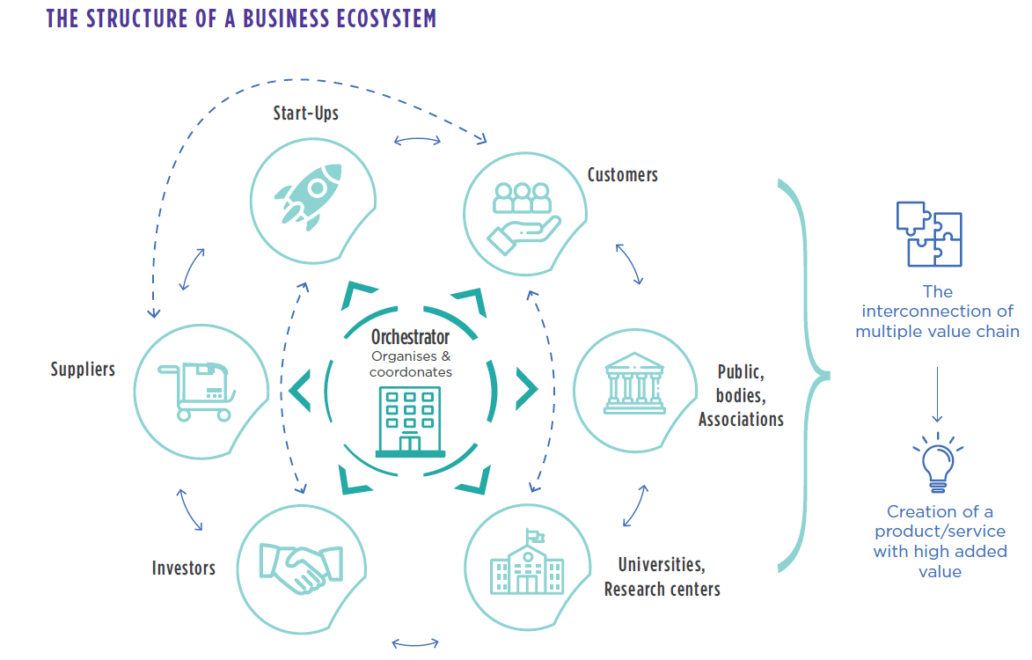While the concept of business ecosystems is no longer new, in recent years, it has made its way onto the strategic agendas of company directors. It’s an idea that once appeared rather theoretical—a community of players all pursuing a common strategic vision—yet today, it is rapidly coming of age as value chains become more complex and digitalized.
To best meet their customers’ needs and remain competitive, companies are increasingly throwing off their “corporate shackles” and pursuing new strategies of cooperation with a diversity of partners—including their own competitors.
How did ecosystem strategies become effective levers for business development? And what are the key success factors? In this publication, we aim to answer these two questions.
Tracing the origins of the business ecosystem concept
Collaboration among businesses isn’t a new phenomenon. As early as 1920, British economist Alfred Marshall set out the dynamics and benefits of corporate concentration.
More recently, Michael Porter (1998) popularized the concept of “clusters” which he described as the geographical concentration of interdependent companies—suppliers of goods and services in broadly similar fields—who deliver a final product in cooperation with universities and competitors. Clusters generate many positive externalities, like cost reductions and the fostering of innovation, and their success largely depends on the geographical proximity of the players. The concept of business ecosystems, which was introduced in the 1990s by James Moore in a Harvard Business Review article (Moore, 1993), challenged this geographic imperative.
Indeed, business networks get built beyond geographic zones, since companies can cooperate at the international level.
What exactly is a business ecosystem?
The concept of a business ecosystem is one of a community of players (companies, organizations, institutions, suppliers, customers, shareholders, etc.), who operate in different fields, yet pursue a common strategic vision.
Cooperation between the different players happens through flexible strategic partnerships rather than traditional joint ventures. These take the form of open innovation platforms, the co-developments of PoCs (Proofs of Concept), and the sharing of infrastructures and resources (human and physical) for a given period of time.
What are the key sucess factors for a business ecosystem?
Choose the ‘’orchestrator’’ who will be responsible for organizing and managing the ecosystem. This leading firm will have responsibility for defining the strategy, identifying potential partners, determining roles and responsibilities, and coordinating the interactions between the different players.
Align the players around a common vision, objectives, and monetization strategy—and create a roadmap that sets out how products and services will be developed. This common strategy must represent the interests of all participants and provide clarity on the rules for sharing the value created. Common performance indicators, a transparent system for allocating revenue or margins, and the building of a pool of resources, are all commonly used tools that ensure effective collaboration between partners and help them achieve their goals.
The ecosystem must be able to react quickly to developments in the market, as well as forge new partnerships—and dissolve existing ones.
Foster co-construction and information sharing. Here, trust can be built by establishing protection mechanisms for intellectual property. This means putting in place contractual agreements about data sharing and contributions from intellectual property.
These indicators must be reviewed regularly in dedicated sessions that bring together all the players, so that they can quickly decide on any corrective actions needed.
The business ecosystem developed by Societe Generale

Françoise Mercadal-Delasalles
Former Group Director of Resources and Innovation & Chief Executive Officer of Crédit du Nord
In a world that is evolving very quickly, both technologically and relationally, Societe Generale is relying on the strength and innovative capacity of the many (both internal and external players) to reinvent the banking sector. Open innovation gives us the opportunity to open ourselves up to other worlds, to think out of the box, to learn from this ecosystem and capitalize on its agility and technological expertise.
Key figures
500
interactions with startups every year
300
startups that have worked with Societe Generale have subsequently launched a successful PoC or have established a strategic/ commercial partnership
8
partnerships with innovative third-party environments
60
internal startups accelerated over a period of six months in 2018




